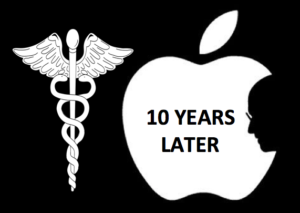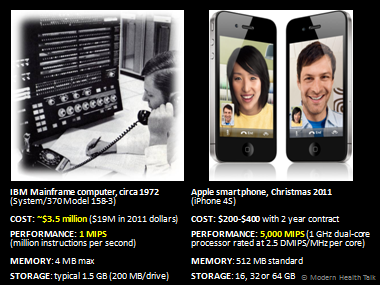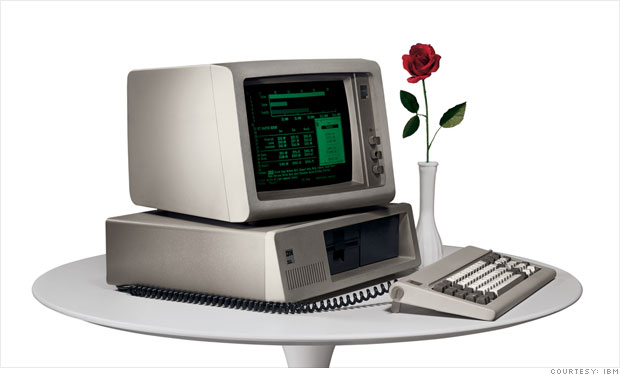10th Apple iPhone Anniversary and Computing Progress
 Before Steve Jobs died, he introduced the Apple iPhone at the Macworld convention in January 2007. The first iPhone units actually shipped to the public on June 29, 2007, so today marks the 10th iPhone anniversary.
Before Steve Jobs died, he introduced the Apple iPhone at the Macworld convention in January 2007. The first iPhone units actually shipped to the public on June 29, 2007, so today marks the 10th iPhone anniversary.
This is a good time to look back on the past and project ahead to the future of tech-enabled healthcare. That future will be driven by the exponentially accelerating pace of tech innovation that we call Moore’s Law. Intel co-founder Gordon Moore first observed the trend of circuits and components getting two times smaller, faster and cheaper every year or two.
In Moore’s Law and the FUTURE of Healthcare, I explored that trend and the eventual blending of science and technology (INFO + BIO + NANO + NEURO). We’re already seeing the effects, with the ability of many doctor functions to move down-market from hospitals & clinics to consumers at home. A continuation of that trend will have a profound effect on future healthcare, as I’ve already written about many times on this blog. 
In my Moore’s Law article I described the IBM System/370 Model 158-3 mainframe computer that I worked on in the early-1970s as a computer operator. It cost about $3.5M, required a large computer room, and consumed so much electricity that liquid cooling of the processor was needed to supplement room air conditioning. I compared it to an iPhone 4S, which then had 100 times more memory, was thousands of times faster, and had wireless access to the Internet, running on batteries.
We often take for granted how much compute capacity we carry in our pocket — more than it took to land a man on the moon — so as we imagine the future, it’s helpful to reflect on just how far we’ve come, and how fast.
I often describe the Apple iPhone as an ideal healthcare gateway between our sensor devices and remote health services. But since it’s also a powerful computer, let’s compare it to the Personal Computer that IBM introduced in August 1981 — 10 years after I worked on that million-dollar mainframe.
Because I got an employee discount and could pay for it through monthly deductions from my paycheck, I bought a full-blown IBM PC for my own use. Here’s the configuration that cost me about $5,000 in 1981. (That’s about $8,000 in today’s dollars, given 3.22% inflation.)
- 4.77 MHz processor, maxed out 64K RAM,
- not one but two 120KB diskette drives (instead of using a cassette tape recorder),
- monochrome display (versus connecting to TV),
- 300 bps telephone modem,
- IBM DOS 1.0,
- BASIC,
- EasyWriter word processor,
- VisiCalc spreadsheet,
- Asynchronous Communications Program, and
- Early Games (a kids game for Adrian).
I started my son Adrian on the PC at age 2, sitting him on my lap and using a piece of cardboard to mask off most of the keyboard – all but the number keypad. Early Games started by teaching the shapes of numbers, such as how a 3 looks like an 8 with its loops open on the left. Today Adrian is 30 and has a two-year old of his own, and kids these days start using smartphones and tablet computers at even earlier ages. And our elderly parents age 82 and over can use them.
Three years later, in 1984, the IBM PC had a faster processor, 10MB hard disk, and color display, as shown in this old TV ad.
Oh by the way, my toothbrush now has an embedded microprocessor that is faster than the first PCs – much faster. Amazingly, it’s nearly ten times faster than the $3.5 million IBM mainframe I described above. A toothbrush! And my iPhone today? It’s more than 10,000 times faster than the mainframe. How time flies. (THEIR LATEST: Philips Sonicare DiamondClean 9700 Series is Everything You Could Ever Ask of a Toothbrush)
So what’s next for iPhone? Here’s a look at just the next version. Watch and then imagine what will come in 10 years, or 20.


RELATED ARTICLES:
Your iPhone could handle 120 million moon missions at once (7/16/2010)